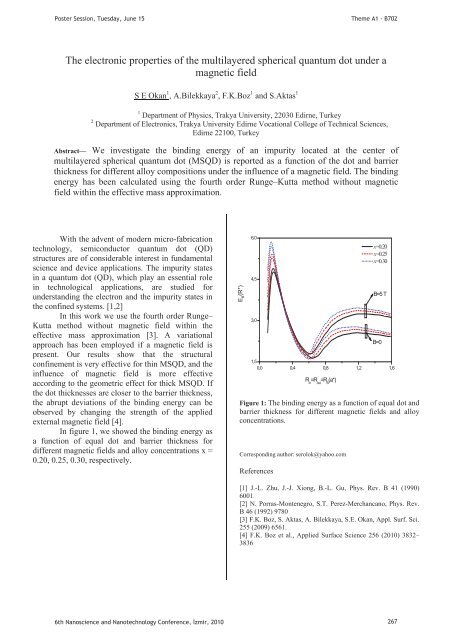Photonic crystals in biology
Photonic crystals in biology
Photonic crystals in biology
Create successful ePaper yourself
Turn your PDF publications into a flip-book with our unique Google optimized e-Paper software.
Poster Session, Tuesday, June 15<br />
Theme A1 - B702<br />
The electronic properties of the multilayered spherical quantum dot under a<br />
magnetic field<br />
S E Okan 1 , A.Bilekkaya 2 , F.K.Boz 1 and S.Aktas 1<br />
1 Department of Physics, Trakya University, 22030 Edirne, Turkey<br />
2 Department of Electronics, Trakya University Edirne Vocational College of Technical Sciences,<br />
Edirne 22100, Turkey<br />
Abstract— We <strong>in</strong>vestigate the b<strong>in</strong>d<strong>in</strong>g energy of an impurity located at the center of<br />
multilayered spherical quantum dot (MSQD) is reported as a function of the dot and barrier<br />
thickness for different alloy compositions under the <strong>in</strong>fluence of a magnetic field. The b<strong>in</strong>d<strong>in</strong>g<br />
energy has been calculated us<strong>in</strong>g the fourth order Runge–Kutta method without magnetic<br />
field with<strong>in</strong> the effective mass approximation.<br />
With the advent of modern micro-fabrication<br />
technology, semiconductor quantum dot (QD)<br />
structures are of considerable <strong>in</strong>terest <strong>in</strong> fundamental<br />
science and device applications. The impurity states<br />
<strong>in</strong> a quantum dot (QD), which play an essential role<br />
<strong>in</strong> technological applications, are studied for<br />
understand<strong>in</strong>g the electron and the impurity states <strong>in</strong><br />
the conf<strong>in</strong>ed systems. [1,2]<br />
In this work we use the fourth order Runge–<br />
Kutta method without magnetic field with<strong>in</strong> the<br />
effective mass approximation [3]. A variational<br />
approach has been employed if a magnetic field is<br />
present. Our results show that the structural<br />
conf<strong>in</strong>ement is very effective for th<strong>in</strong> MSQD, and the<br />
<strong>in</strong>fluence of magnetic field is more effective<br />
accord<strong>in</strong>g to the geometric effect for thick MSQD. If<br />
the dot thicknesses are closer to the barrier thickness,<br />
the abrupt deviations of the b<strong>in</strong>d<strong>in</strong>g energy can be<br />
observed by chang<strong>in</strong>g the strength of the applied<br />
external magnetic field [4].<br />
In figure 1, we showed the b<strong>in</strong>d<strong>in</strong>g energy as<br />
a function of equal dot and barrier thickness for<br />
different magnetic fields and alloy concentrations x =<br />
0.20, 0.25, 0.30, respectively.<br />
E B<br />
(R*)<br />
6,0<br />
4,5<br />
3,0<br />
1,5<br />
0,0 0,4 0,8 1,2 1,6<br />
Figure 1: The b<strong>in</strong>d<strong>in</strong>g energy as a function of equal dot and<br />
barrier thickness for different magnetic fields and alloy<br />
concentrations.<br />
Correspond<strong>in</strong>g author: serolok@yahoo.com<br />
References<br />
R <strong>in</strong><br />
=R out<br />
=R B<br />
(a*)<br />
x=0.20<br />
x=0.25<br />
x=0.30<br />
B=5 T<br />
B=0<br />
[1] J.-L. Zhu, J.-J. Xiong, B.-L. Gu, Phys. Rev. B 41 (1990)<br />
6001<br />
[2] N. Porras-Montenegro, S.T. Perez-Merchancano, Phys. Rev.<br />
B 46 (1992) 9780<br />
[3] F.K. Boz, S. Aktas, A. Bilekkaya, S.E. Okan, Appl. Surf. Sci.<br />
255 (2009) 6561.<br />
[4] F.K. Boz et al., Applied Surface Science 256 (2010) 3832–<br />
3836<br />
6th Nanoscience and Nanotechnology Conference, zmir, 2010 267













